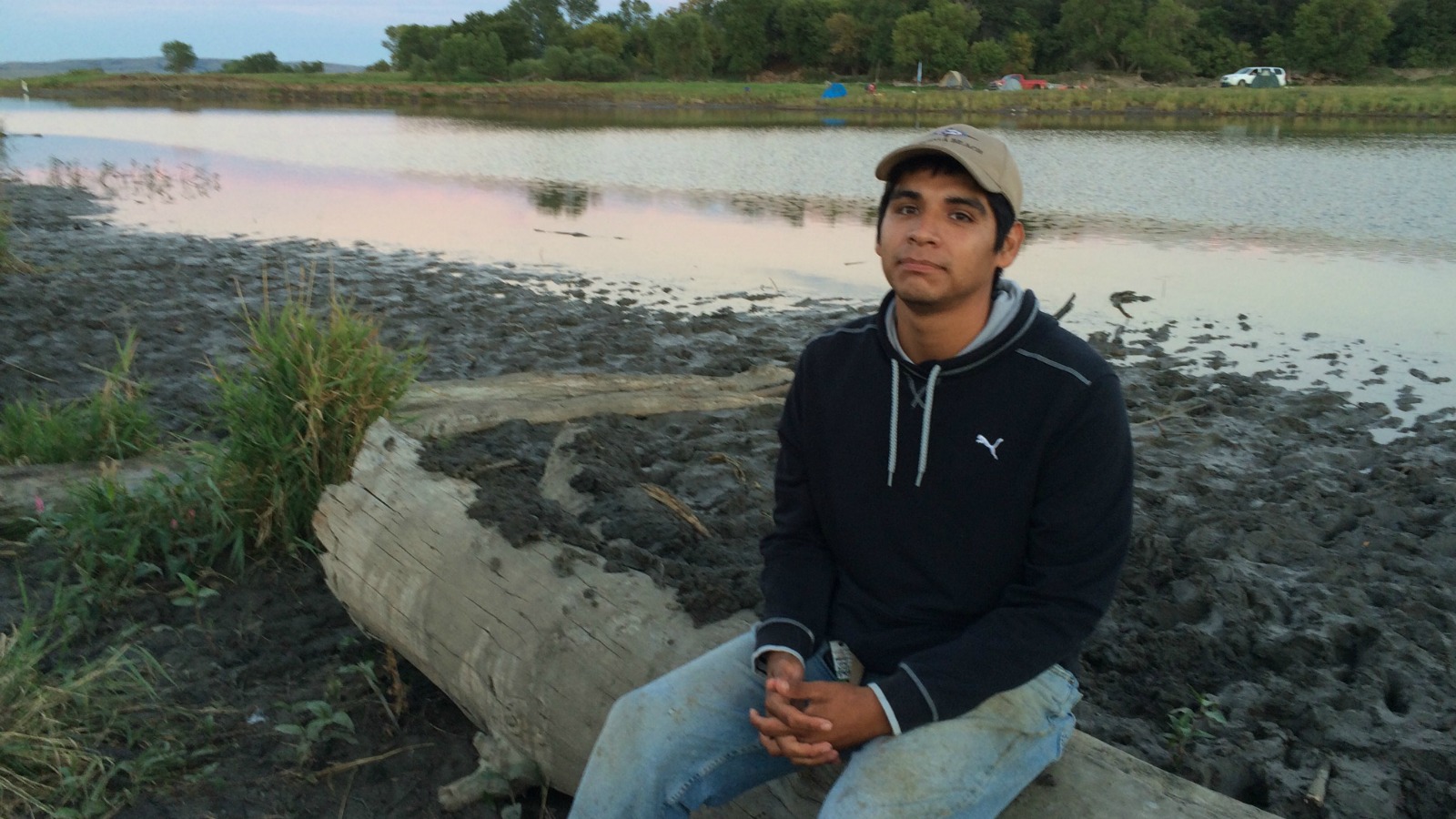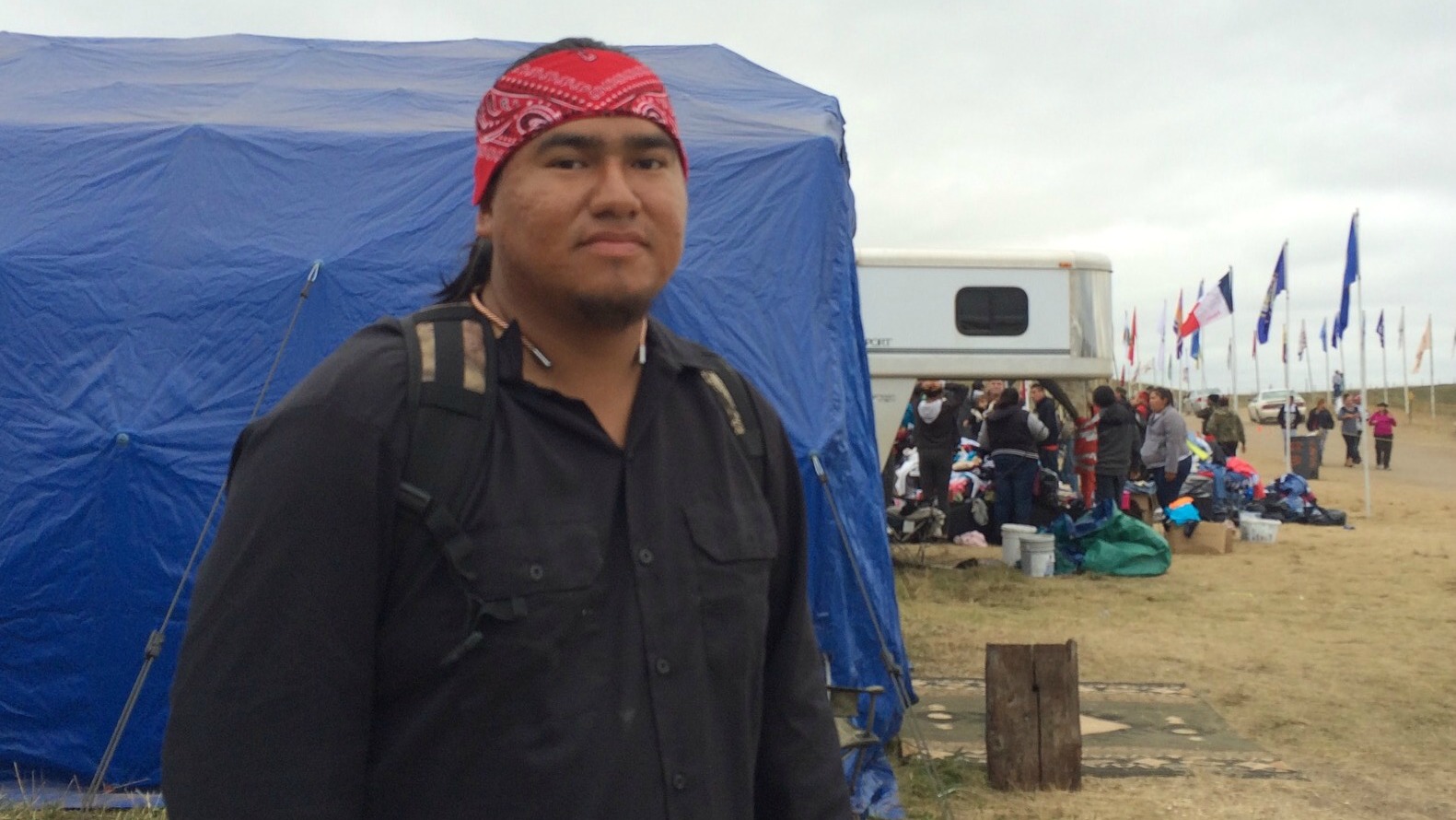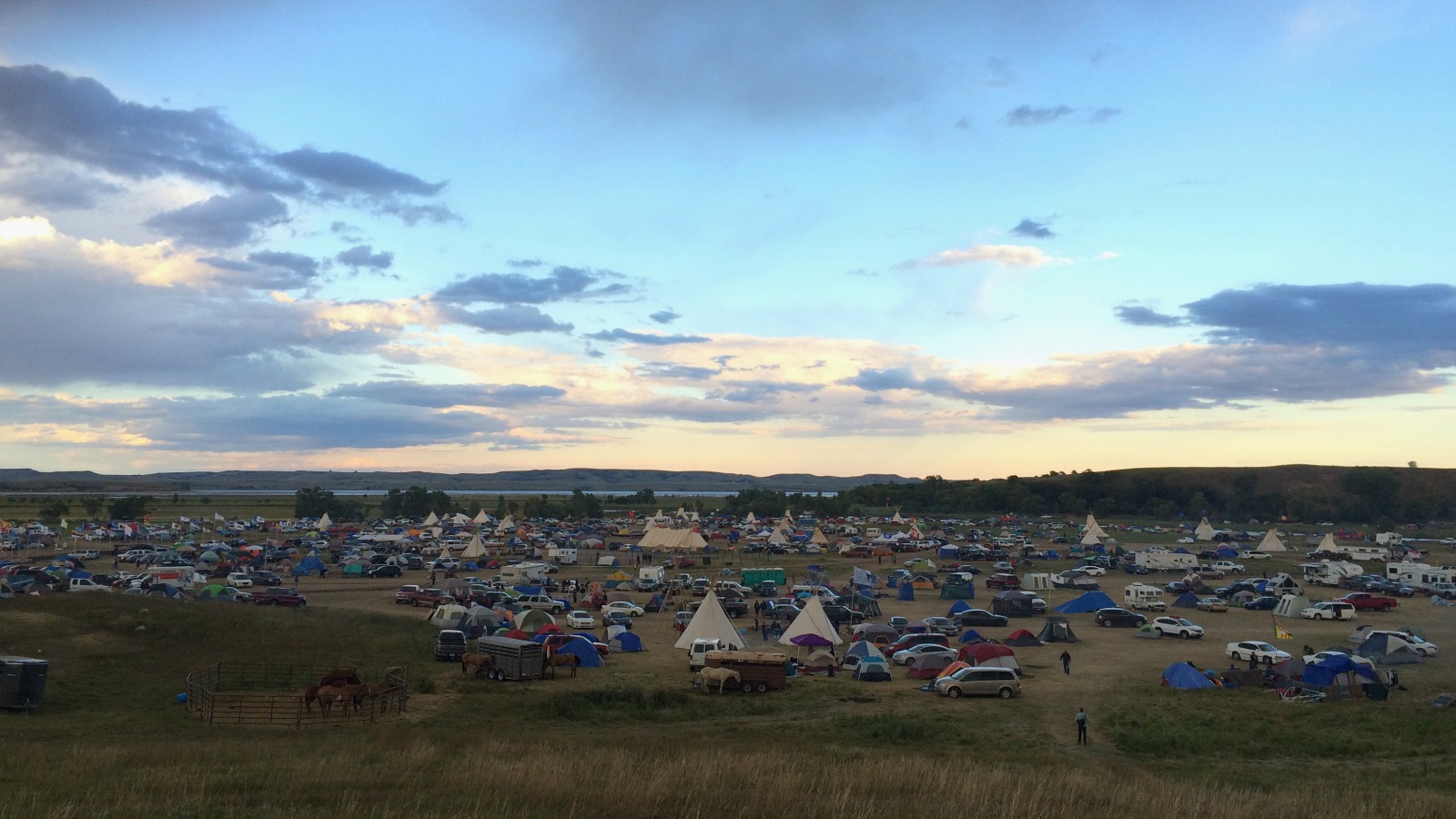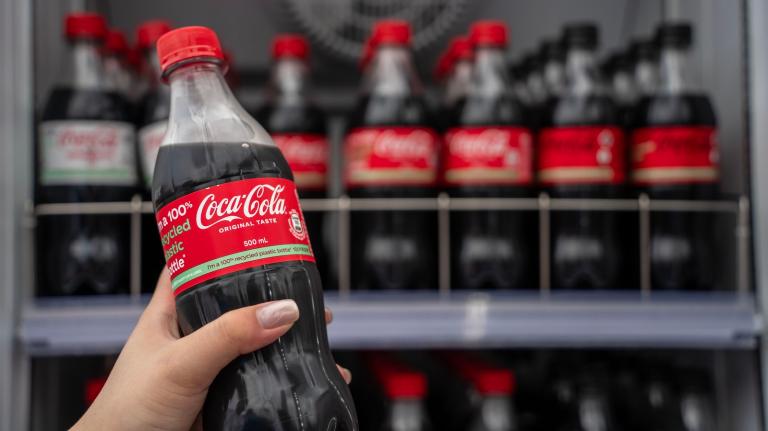At sundown, Montgomery Brown meets me by the information tent. He has a paper plate piled with brownies in one hand and a toothbrush in the other. The 25-year-old youth organizer and Navy-trained combat medic from the Standing Rock Sioux tribe has been up since daybreak.
Brown and I walk past hand-painted “NO MEDIA” signs. We wander through a kitchen, where volunteers are chopping vegetables and boiling pots of soup over an open fire, past kids chasing each other in a game of tag. Clusters of towering white teepees and neon, synthetic tents hug the ground. They are grouped into small encampments for a half mile in every direction, around central fires that burn day and night and send plumes of smoke into the sky.
“Every time I walk around this camp,” Brown says, “… I hear those kids laughing and playing — it just reaffirms that I’m not just fighting for myself or my family. I’m fighting for everybody.”
Welcome to the camp that is ground zero for the pushback against America’s new mega-pipeline. Less than a mile upstream on both sides of the Missouri River, Dakota Access LLC, a subsidiary of Texas-based Energy Transfer Partners, has broken ground on a new 1,172-mile pipeline that would transport more than 500,000 barrels of Bakken crude oil per day across the heartland. Called the Dakota Access Pipeline (DAPL for short) or the Bakken Pipeline, it is the largest crude pipeline proposed in the American West since the defeat of Keystone XL, and it is on track to be operational this winter.
The pipeline, the tribe and its lawyers say, endangers Standing Rock’s only source of drinking water by cutting across the Missouri. Construction, according to tribal historians, has also unearthed sacred burial sites and artifacts across swaths of land near the reservation’s borders. On Sept. 9, a federal judge denied the Standing Rock Sioux Tribe’s motion for an injunction against the U.S. Army Corps of Engineers, but, within an hour, the Department of Justice, the Department of the Interior, and the Army stepped in to urge Dakota Access LLC to halt pipeline construction in the area within a 20-mile radius of Lake Oahe. On Sept. 12, Standing Rock appealed the court’s decision and added additional claims to their suit against the Army Corps. (Follow Grist’s coverage of the pipeline here.)
What began in April as a small group of about 20 members of the Standing Rock Sioux gathering in prayer and keeping constant vigil on the riverbank has swelled to a sprawling encampment of more than a thousand. The outpouring of support — and people — into the camp has grown into a bona fide movement that’s rallying to protect both native treaty rights and the integrity of our planet’s resources. The inhabitants promise to defend the Missouri River from the pipeline no matter what.
Here’s a glimpse of what life at the camp is like.

Montgomery Brown, 25, has helped to organize and chaperone youth events, including a nearly 2,000 mile intertribal relay run to Washington, D.C.Xian Chiang-Waren
“We all drink water.”
They’ve arrived at all hours of the day for the past three weeks, from all corners of the country. Members of more than 280 indigenous tribes are at the camp, which is located just steps away from the border of the Standing Rock Sioux Reservation. There are Black Lives Matter groups and grassroots organizers. From afar, the occupation has received support from mainstream environmental groups (Sierra Club, 350), politicians (Bernie Sanders, Robert F. Kennedy, Jr.), and even celebrities (Leonardo DiCaprio, Rosario Dawson, Susan Sarandon, Mark Ruffalo, Shailene Woodley).
Some of the people gathered here have not, traditionally, been allies. Members of the Crow Nation haven’t been welcome guests in Sioux territory since 1876, when they allegedly scouted for Custer at the Battle of the Little Bighorn. On Aug. 27, Crow Nation representatives bearing peace pipes and hundreds of pounds of buffalo meat arrived at the camp gates and were met formally by Standing Rock leaders. A murmur went through the crowd — this was history.
“There has never been anything like this in Indian country before, ever,” said LaDonna Brave Bull Allard, a tribal historic preservation officer for the Standing Rock Sioux. Recently, Allard found herself at lunch with a member of the Crow and a member of the Pawnee — a meeting that would have been inconceivable until now.
It helps that the unifying thread of the protest — water — is so undeniably universal. The Missouri River provides water for Standing Rock Reservation, as well as for other towns, agricultural operations, and natural habitats downstream. Standing Rock’s lawyers say a spill would cause an “existential threat” to the tribe’s resources and way of life. Recent spills in the region include a 1-million-gallon crude spill into the Kalamazoo River in 2010, and a 2015 spill of 50,000 gallons into the Yellowstone River in Montana.
“We have an understanding as a people that we’re all related, at some point,” said tribal council member Robert Taken Alive. “We all drink water.”
Origins
The story of the Dakota Access Pipeline resistance actually begins three miles away, on the southern side of the Cannonball River, at a significantly smaller encampment called Sacred Stone Camp. The camp is owned by LaDonna Brave Bull Allard, who has known since 2014 that the proposed route for the Dakota Access Pipeline would cut through her property, near her water well and a family member’s grave. At the beginning of April, she and around 20 others began to camp and pray that others would join them to halt the pipeline.
In July, she got word that construction would begin and sent out a video message on Facebook for help. Her prayer was answered.
“People just started coming,” Allard said as she sat by the Sacred Stone Camp fire in late August. “People hawked everything they could, and I thought, Oh my God we’ve got to take care of these people. People would come and their cars broke down, and they were here to stay.” Allard began using her paycheck to feed and shelter the volunteers that drove into camp. Soon, though, their numbers grew to the point that Sacred Stone could not accommodate them, and activists sent the overflow to the camp across the river.
The intentions of the original group at Sacred Stone is likely the reason that the first thing one learns upon arriving at camp is that most campers do not consider themselves environmental “protesters.” They call themselves “protectors” of the earth and its resources. They are not interested in fighting, but in defending. “We’re not here for violence or vengeance,” said Robert Eber, who identifies himself as “the maintenance guy,” and says he’d been at Sacred Stone since day one. “We’re here for love and healing, for all of mankind.”
Now, the camp across the river has evolved into a small city. Tidy donations tents are stocked with piles of warm clothing, blankets, women’s sanitary items, baby food, and firewood. There’s a daytime school for children to attend. When the state pulled water and port-a-potties from the camp, the tribe replaced them within an afternoon. Each day, hundreds of campers are fed for free.

Dale American Horse, Jr., 26, locked himself to construction equipment on Aug. 31, putting his “body on the line” to block Dakota Access.Xian Chiang-Waren
Unrest
In the prairie, days are parching hot and the nights are cold. Torrential rains drive people into their cars or into the lobby of the nearby Prairie Knights Casino. Planes fly over the camp throughout the night. A security checkpoint staffed by state troopers on Route 1806, the road from Bismarck to Standing Rock, reroutes cars on a poorly marked detour through unpaved county roads. The state withdrew emergency relief services after hearing rumors of pipe bombs.
At the camp, the message that tribal leaders pipe through the loudspeakers each day is one of peace and unity. Leaders frequently caution activists not to treat law enforcement or construction workers with hostility. Still, tensions have steadily escalated.
Twenty-eight people were arrested in August during a peaceful demonstration. Dakota Access LLC subsequently sued the arrestees, including Standing Rock Tribal Chair David Archambault, for trespassing — a rich irony for these descendants of America’s natives, to be arrested on the land where their ancestors were pushed during the forced migrations of the 19th century.
On Aug. 31, seven more activists were arrested, including two men who locked themselves to construction equipment. On Sept. 6, two activists locked themselves to excavators at different construction sites in actions that were not sanctioned by tribal leadership. Several people, including presidential candidate Jill Stein, who arrived at the scene, spray-painted construction equipment with phrases like “decolonize” and “black snake kills,” the latter a reference to a Lakota prophecy about a black snake that would come to America with the power to destroy the world, or unify it.
On Sept. 13, in the midst of a global day of actions in solidarity with Standing Rock, more than 20 people, including two journalists, were arrested for criminal trespass. Dozens of law enforcement officials in riot gear and armed with assault rifles were present.
Robert Eber, “the maintenance guy,” was distressed by the images he had seen on Facebook of young people defacing bulldozers and standing atop construction equipment wearing bandanas. He worried the public would assume that the camps were encouraging violence. “We have no guns,” he said. “We’re armed with prayer.”
The seventh generation
The “black snake” isn’t the only prophecy making the rounds at camp: According to Crazy Horse, a revered mid-19th century Oglala Lakota chief who led tribes to victory at Little Bighorn, the Lakota people would undergo generations of spiritual genocide and environmental degradation following American colonization of the West. Then, a seventh generation would wake up and rise — a generation that would lead the healing and restoration of the planet, rejuvenate a forgotten spirituality, and create harmony among people of all colors and creeds.
“You see it happening,” said Allison Renville, a political activist and 32-year-old member of the Sisseton Wahpeton Oyate Sioux tribe. Young people, when asked why they had come to camp, frequently referenced a sense of fulfilling destiny.
The younger generations at camp are there to fight a pipeline, but some also say they have come to heal from the wounds that genocide inflicted, and to embrace their heritage. At dinner around the campfire one night, a young Abenaki man explained to some non-native outsiders that his generation was seeking to reclaim environmental and earth-based wisdom from the elders before they passed. “Ceremony seems to have skipped a generation or two,” he said. “We’re bringing it back.” By the last week of August, some of the camp’s young people had built two sweat lodges near the river, in accordance with tradition.
“It’s all the young people that did this,” says LaDonna Brave Bull Allard. “When the young people stood up, people stood up with them.”
Along with prayer and fate, the young people at camp are using more visible tools for resistance. They have used hashtags and Facebook Live to broadcast the camp’s message. In July, Bobbi Jean Three Legs, Montgomery Brown, and Joseph White Eyes, all in their 20s, organized and chaperoned a nearly 2,000 mile, intertribal relay run from North Dakota to Washington, D.C. (among three other runs), to deliver a petition of more than 160,000 signatures against the pipeline to the White House and to the Army Corps of Engineers in person.
“If this pipeline goes through, it is gonna affect our generation the most,” said Bobbi Jean Three Legs to a packed crowd at a youth concert on the evening of Sept. 8. “If anything, it’s going to affect the kids that aren’t born yet. We don’t want that.”
Whether the Dakota Access Pipeline actually goes through is still up in the air. Energy Transfer Partners, which has already invested $1.6 billion in the project, has publicly vowed to see the project through to completion. The Standing Rock tribe and its supporters, in turn, have vowed to stay at camp until the pipeline project is called off altogether.
No matter the outcome, this fight is just the beginning for many at camp. One dusty afternoon, as we hid from the sun under a brown tarp near the main artery of the camp, a tribal council member told me that the camp “had already won” a significant battle just “by coming together.” After all, the Dakota Access Pipeline is just one of many threats to tribal nations, clean water, and a warming planet. This generation of protectors has a future to defend.
Ed. note: An earlier version of this story incorrectly stated the year in which the Battle of the Little Bighorn took place.



